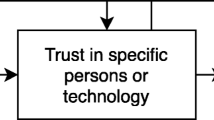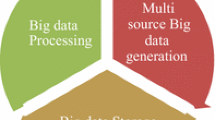Abstract
Existing research on developing privacy models, although seem persuasive, are essentially based on user, role or service identification. Such models are incapable of automatically adjusting privacy needs of consumers or organizations to the context in which the data is accessed. In this work we present a context based privacy model (CBPM) that leverages the context in which the information content is accessed. We introduce the concepts of donation and adoption for privacy configuration by extending CBPM to collective-CBPM (C-CBPM), bearing the analysis upon the notions of collective intelligence and trust computation. The efficacy of the proposed C-CBPM model is demonstrated by implementing it in various application domains such as, humanitarian assistance and disaster relief operations. CBPM is also implemented as a framework that assists in the comparison and extension of existing role or service based privacy and access control models.





Similar content being viewed by others
Notes
http://www.odi.org.uk/resources/download/3250.pdf, retrieved on August 16, 2010.
http://www.nytimes.com/2010/10/23/technology/23google.html, retrieved on October 23, 2010.
http://www.bbc.co.uk/news/world-south-asia-10984477, retrieved on August 16, 2010.
http://www.reliefweb.int/rw/rwb.nsf/db900SID/LSGZ-89GD7W?OpenDocument, retrieved on November 12, 2010.
http://fts.unocha.org/reports/daily/ocha_R24_E15913___1408160300.pdf, retrieved on August 12, 2011.
http://www.coe-dmha.org/pakistan2010.html, retrieved on October 23, 2010.
http://www.pakistan.sahanafoundation.org/eden/default/index, retrieved on August 20, 2010.
http://www.irinnews.org/Report/90541/PAKISTAN-Securing-aid-delivery, retrieved on September 22, 2010.
http://www.cbn.com/cbnnews/world/2010/August/Report-Taliban-Kill-3-Christian-Aid-Workers/, retrieved on August 30, 2010.
It shares some issues with cold-start problem. Usability problem is naive user’s lack of experience to build a CBPM matrix.
References
Adams A, Sasse MA (2001) Privacy in multimedia communications: protecting users, not just data. People and computers XV: interactions without frontiers: joint proceedings of HCI 2001 and IHM 2001. Springer, pp 49–69
Agarwal N, Liu H (2009) Trust in blogosphere. In: Liu L, Tamer Özsu M (eds) Encyclopedia of database systems. Springer, New York, pp 3187–3191
Agarwal N, Liu H, Tang L, Yu P (2008) Identifying influential bloggers in a community. 1st International conference on web search and data mining (WSDM08). California, pp 207–218
Agarwal N, Galan M, Liu H, Subramanya S (2010) WisColl: collective wisdom based blog clustering. J Inf Sci 180(1):39–61
Baker CR, Shapiro B (2003) Information technology and the social construction of information privacy: reply. J Acc Public Policy 22(3):287–290
Braghin AC, Agostino BC, Riccardo BF (2008) Information flow security in boundary ambients Information and computation. Elsevier, Amsterdam, pp 460–489
Brewer DDF, Nash DMJ (1989) The Chinese wall security policy. IEEE symposium on research in security and privacy, pp 206–214
Buchmayr M, Kurschl W (2010) A survey on situation-aware ambient intelligence systems. J Ambient Intell Humaniz Comput 2:175–183
Chai S, Salerno J, Mabry P (2010) Third international conference on social computing, behavioral modeling, and prediction, SBP 2010, Bethesda, MD, USA, 30–31 March 2010, Springer
Chou S (2004) Dynamic adaptation to object state change in an information flow control model. J Inf Softw Technol 46(11):729–737
Clarke C (2010) Intelligence collection through social media. Navy Imagery Insider 2010:4
Foley S (1990) Secure information flow using security groups. Computer security foundations workshop III, pp 62–72
Francesco N, Martini L (2007) Instruction-level security analysis for information flow in stack-based assembly languages. J Inf Comput 205(9):1334–1370
Gilburd B, Schuster A, Wolff R (2004) k-TTP: a new privacy model for large-scale distributed environments. In: Proceedings of the tenth ACM SIGKDD, pp 563–568
Goncalves G, Maranda A (2008) Role engineering: from design to evolution of security schemes. J Syst Softw 81(8):1306–1326
Gross T (2008) Cooperative ambient intelligence: towards autonomous and adaptive cooperative ubiquitous environments. Int J Auton Adapt Commun Syst (IJAACS) 1(Suppl 2):270–278
Hong J, Suh E, Kim S (2009) Context-aware systems: a literature review and classification. J Exp Syst Appl 36(4):8509–8522
Howe J (2006) The rise of crowdsourcing. Wired, 14 June 2006
Jindal R, Kiran C (2010) Dual layer privacy model for hidden databases. Int J Comput Appl 1(13):22–25 (published by foundation of computer science)
Kapsalis V, Hadellis L, Karelis D, Koubias S (2006) A dynamic context-aware access control architecture for e-services. J Comput Secur 25(7):507–521
LaPadula LJ, Bell DE (1996) Secure computer systems: a mathematical model. J Comput Secur 4:239–263
Liu H, Salerno J, Young M (2008) Proceedings of the social computing, behavioral modeling, and prediction (SBP08). Springer, Arizona
Liu H, Salerno J, Young M (2009) Proceedings of the social computing and behavioral modeling (SBP09). Springer, Arizona
Martha V, Ramaswamy S, Agarwal N (2010) CBPM: context based privacy model. 2nd international symposium on privacy and security applications (PSA-10) held in conjunction with IEEE international conference on privacy, security, risk. IEEE, Minneapolis
Maximilien EM, Grandison T, Liu K, Sun T, Richardson D, Guo S (2009) Enabling privacy as a fundamental construct for social networks. In: Computational science and engineering, 2009. CSE ‘09 International conference on 29–31 August 2009, vol 4, pp 1015–1020
McLean J (1990) Security models and information flow. IEEE symposium on research in security and privacy, pp 180–187
Moniruzzaman M, Barker K, Delegation of access rights in a privacy preserving access control model. In: Privacy, security and trust (PST), 2011 ninth annual international conference on 19–21 July 2011, pp 124–133
Nau D, Mannes A (2009) Proceedings of the third international conference on computational cultural dynamics (ICCCD-09). The AAAI Press, Maryland
Nau D, Wilkenfeld J (2007) Proceedings of the first international conference on computational cultural dynamics (ICCCD-07). The AAAI Press, Maryland
Nissenbaum H (2009) Privacy in Context. Stanford Law & Politics, Stanford
Subrahmanian VS, Kruglanski A (2008) Proceedings of the second international conference on computational cultural dynamics (ICCCD-08). The AAAI Press, Maryland
Sweeney L (2002) k-Anonymity: a model for protecting privacy. Int J Uncertain Fuzziness Knowl-Based Syst 10(5):557–570
Tbahriti S-E, Mrissa M, Medjahed B, Ghedira C, Barhamgi M, Fayn J (2011) Privacy-aware DaaS services composition. In: Hameurlain A, Liddle SW, Schewe K-D, Zhou X (eds) ‘DEXA (1)’. Springer, pp 202–216
Acknowledgments
This work was supported, in part, by grants from the US National Science Foundation (under Grant Nos. IIS-1110868, CNS-0619069, EPS-0701890, OISE-0729792, CNS-0855248 and EPS-0918970) and the US Office of Naval Research (under Grant Numbers N000141010091 and N000141410489). We gratefully acknowledge this support.
Author information
Authors and Affiliations
Corresponding author
Rights and permissions
About this article
Cite this article
Venakata Swamy, M., Agarwal, N. & Ramaswamy, S. C-CBPM: collective context based privacy model. J Ambient Intell Human Comput 5, 881–895 (2014). https://doi.org/10.1007/s12652-014-0241-z
Received:
Accepted:
Published:
Issue Date:
DOI: https://doi.org/10.1007/s12652-014-0241-z




